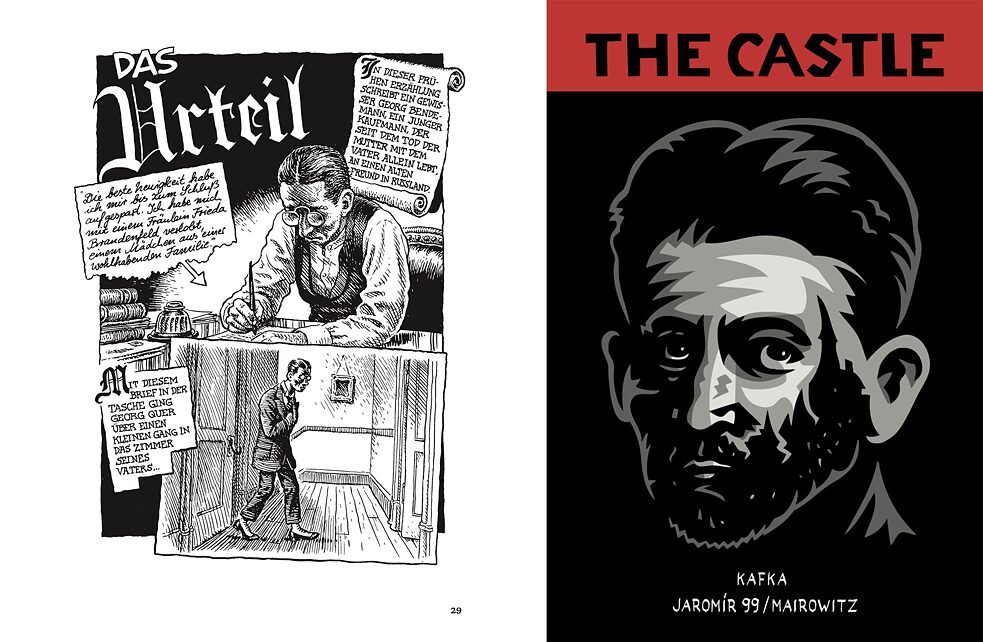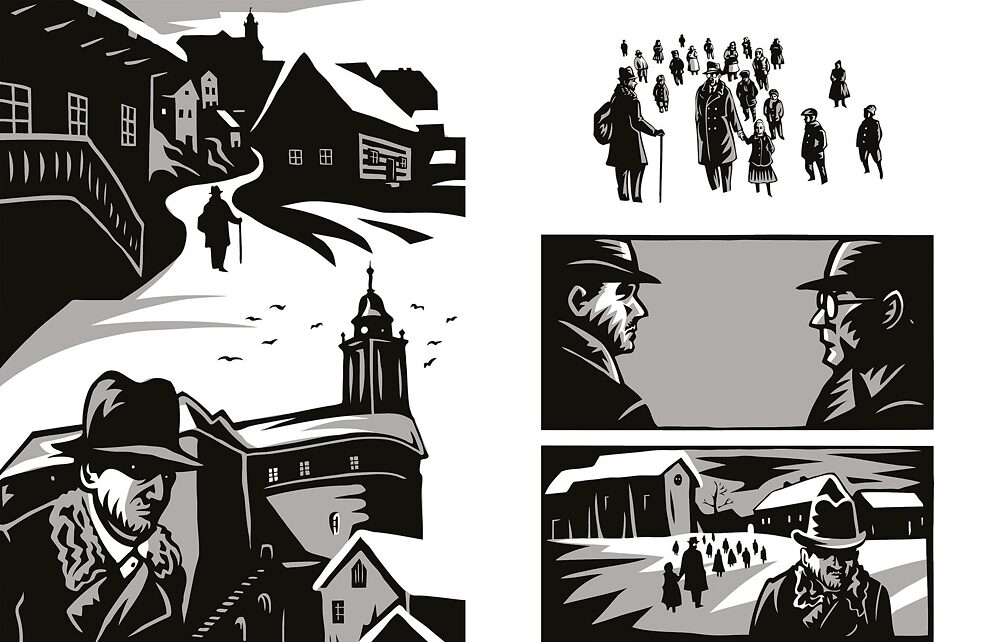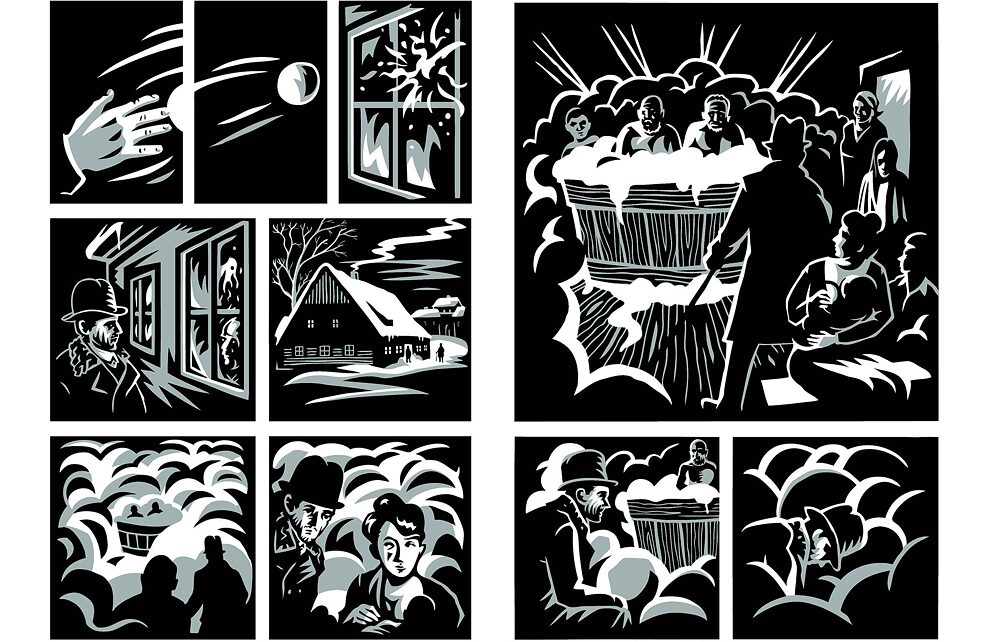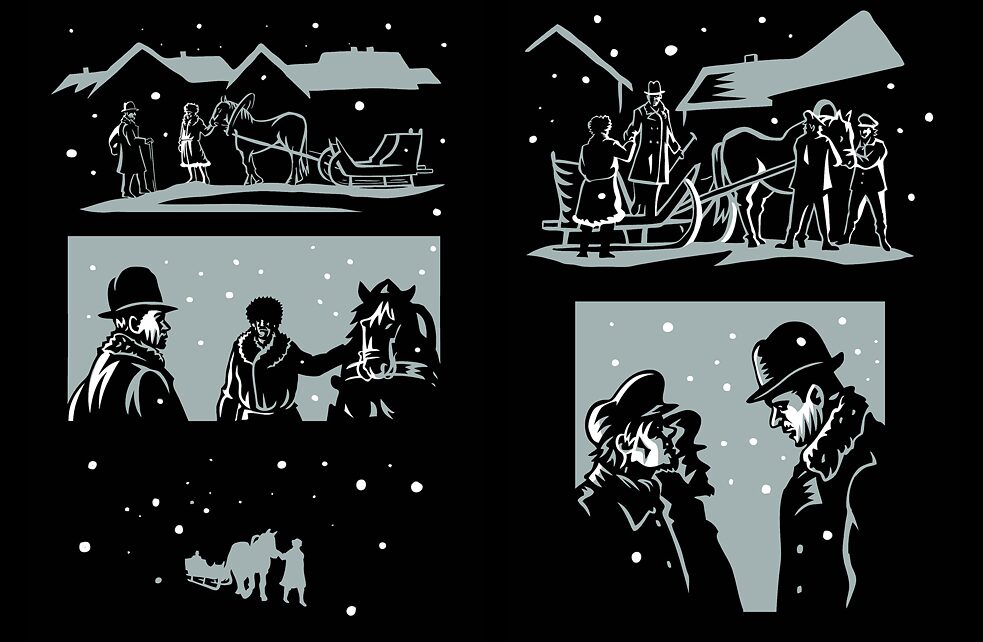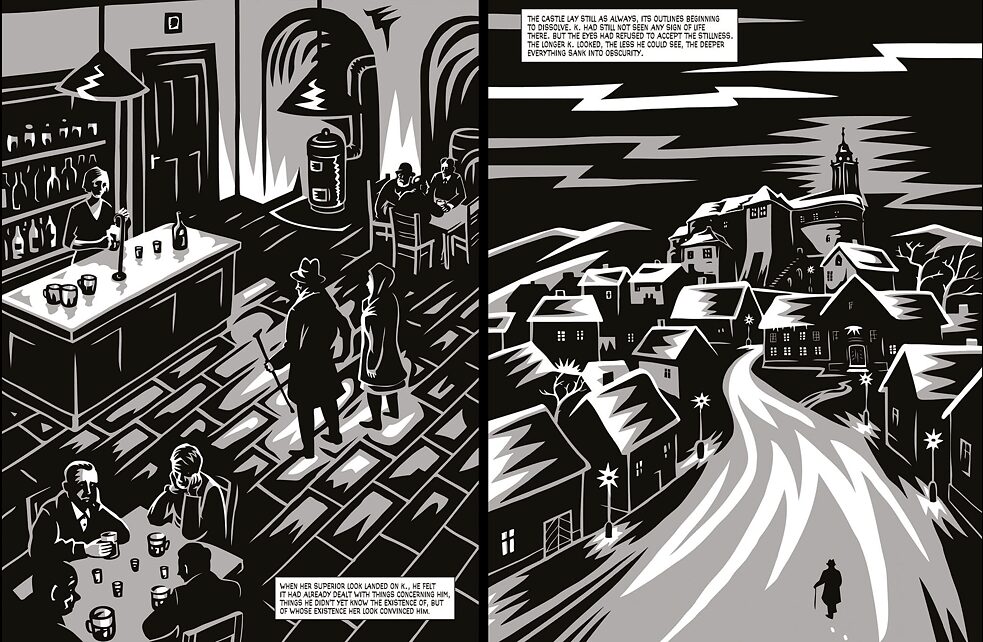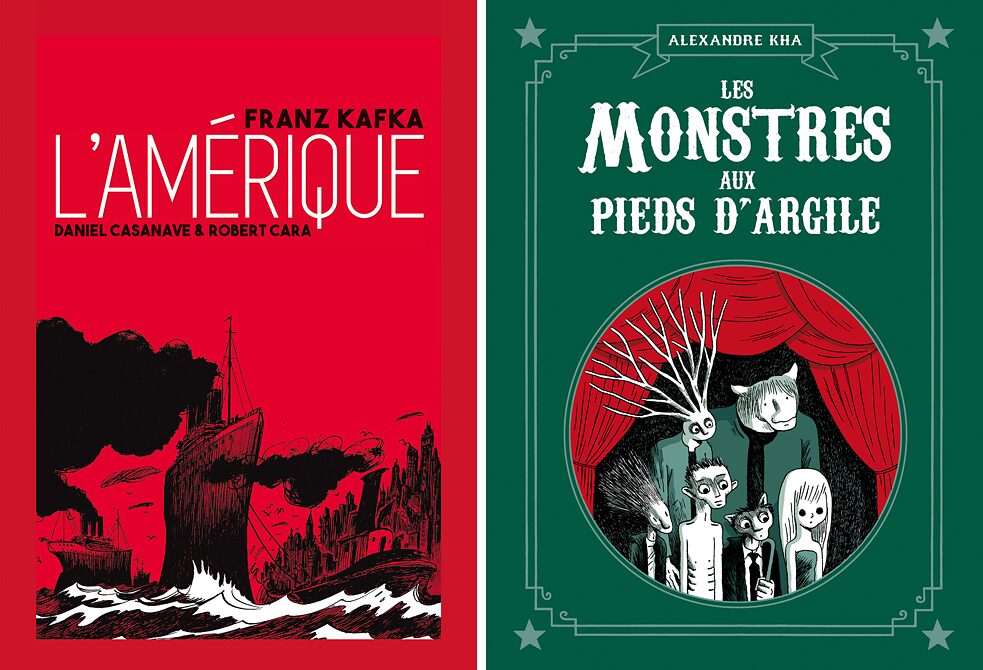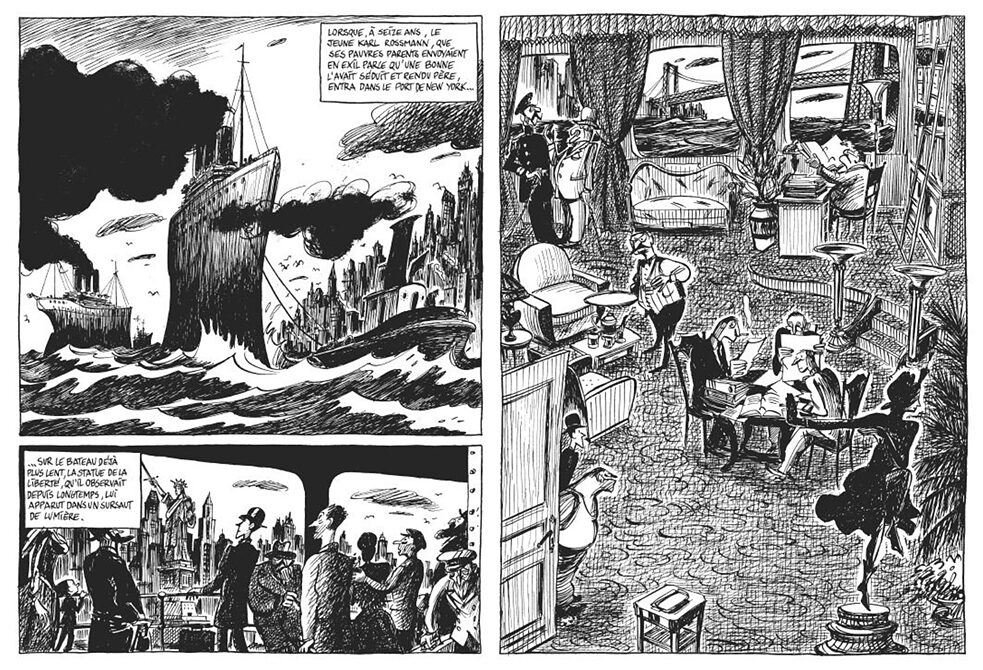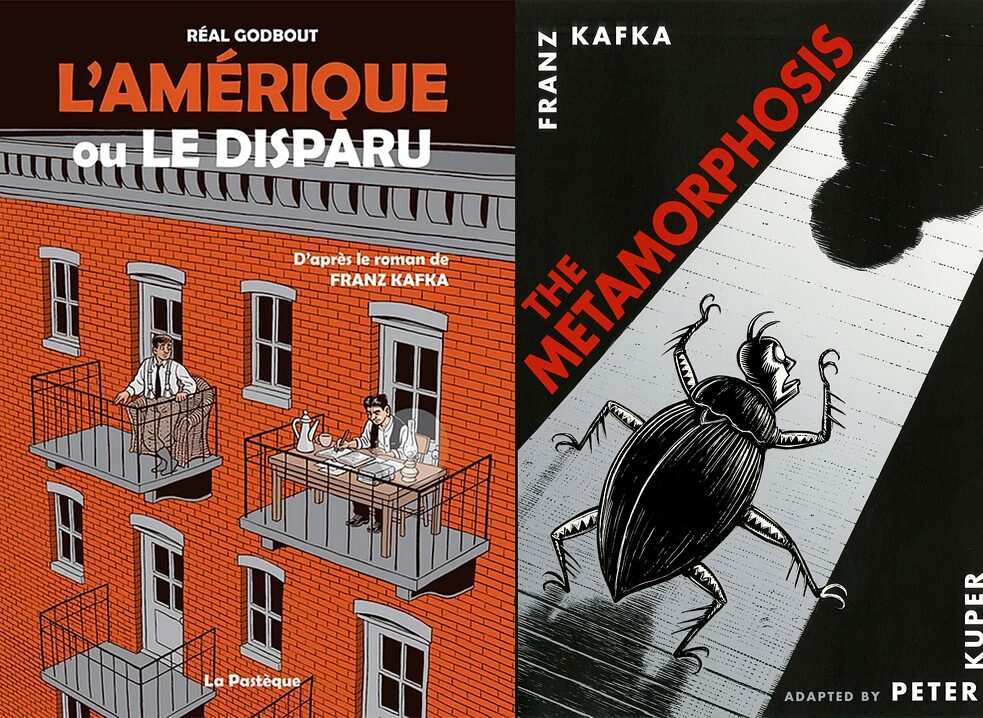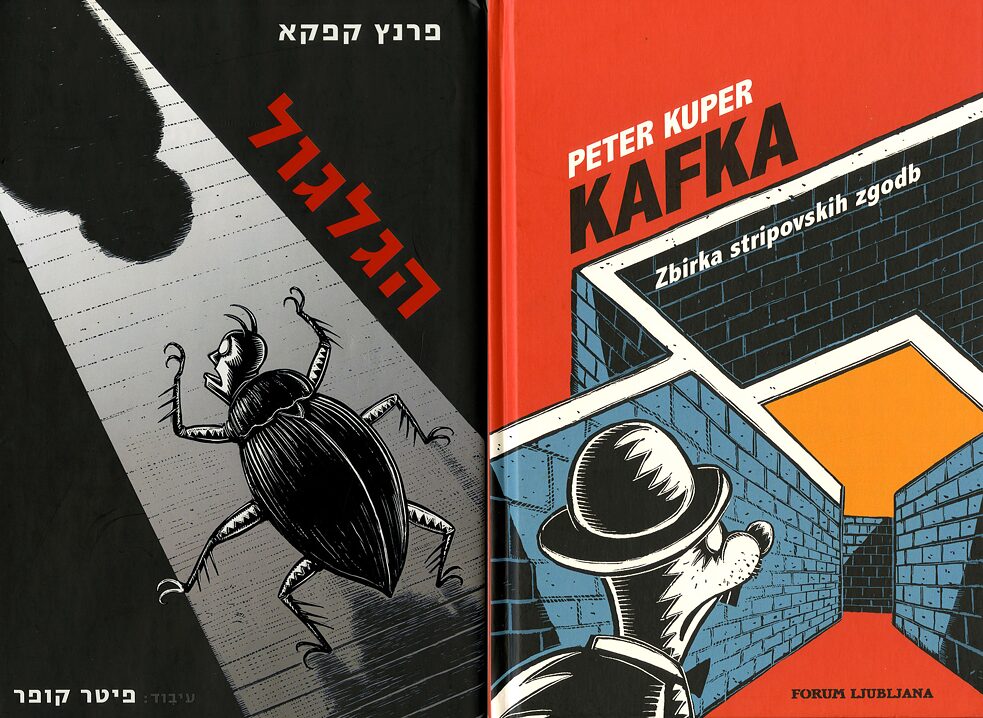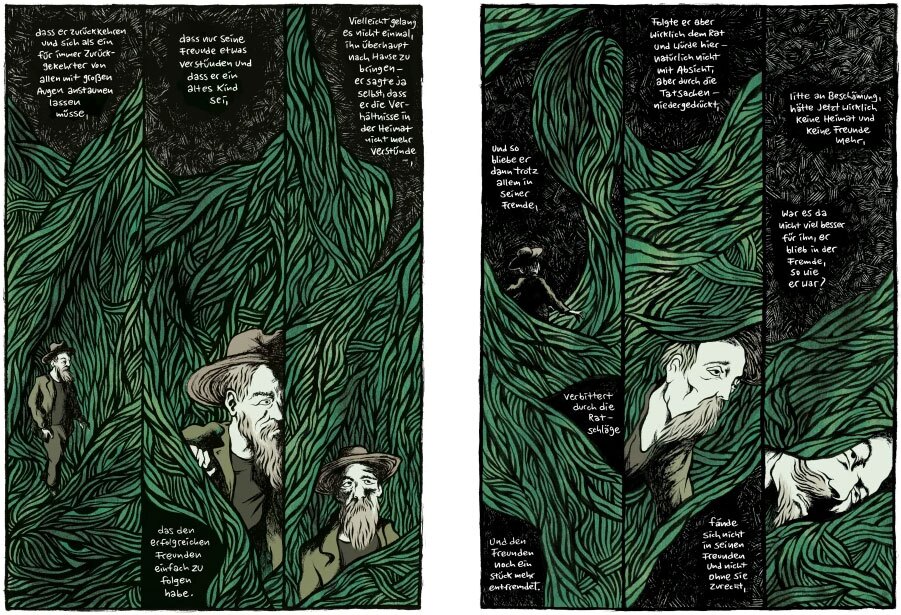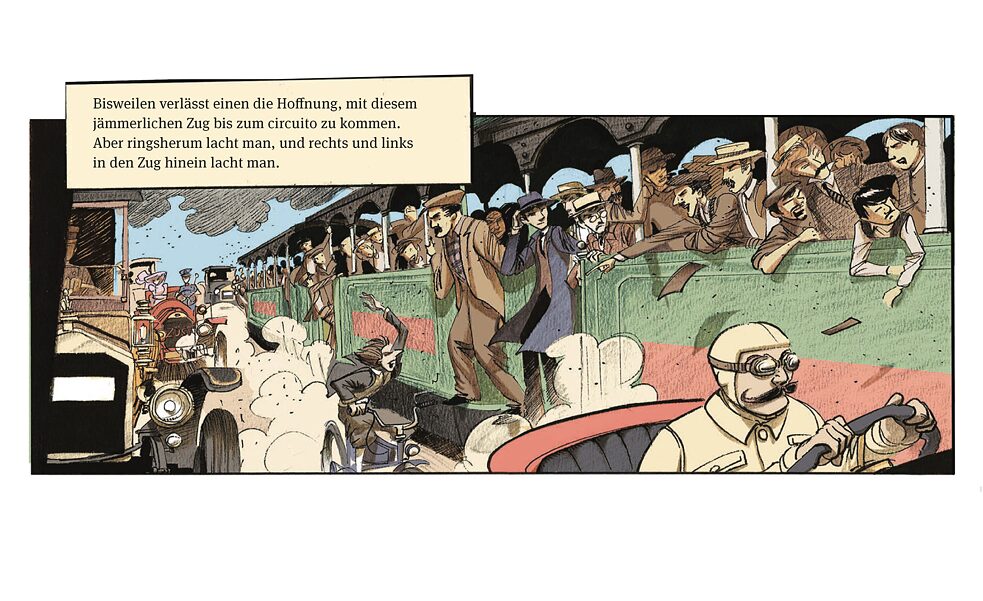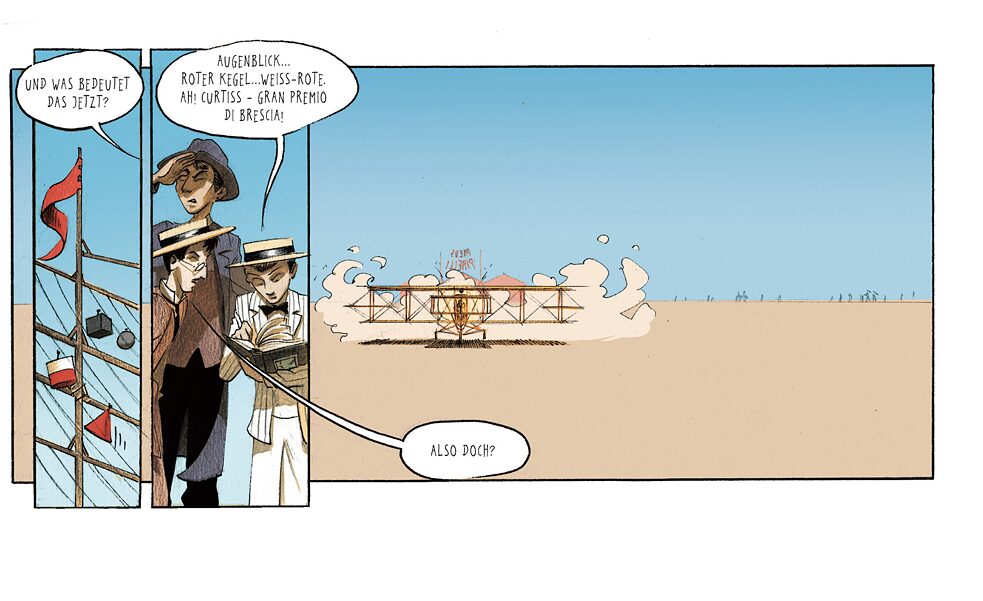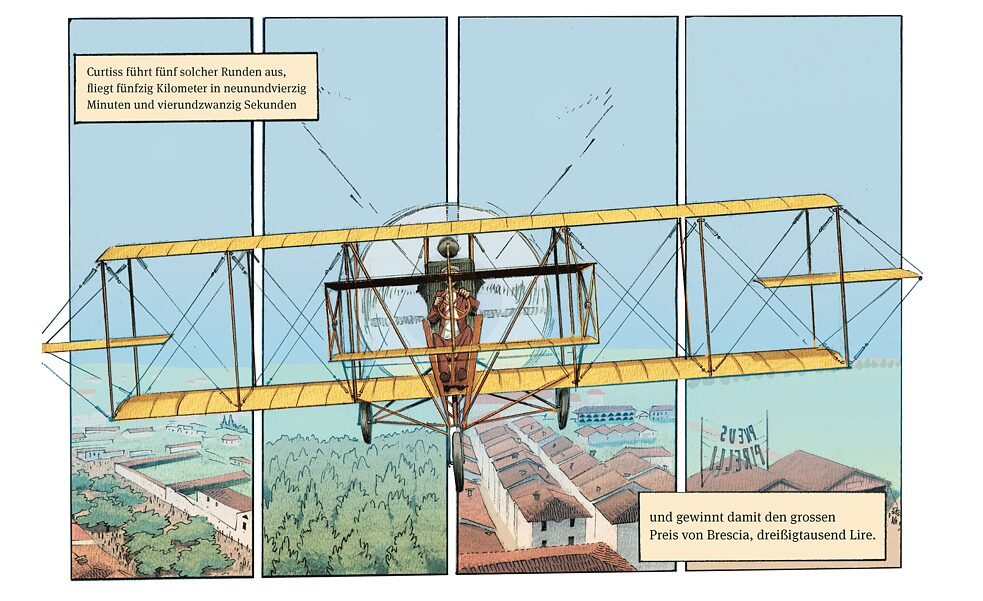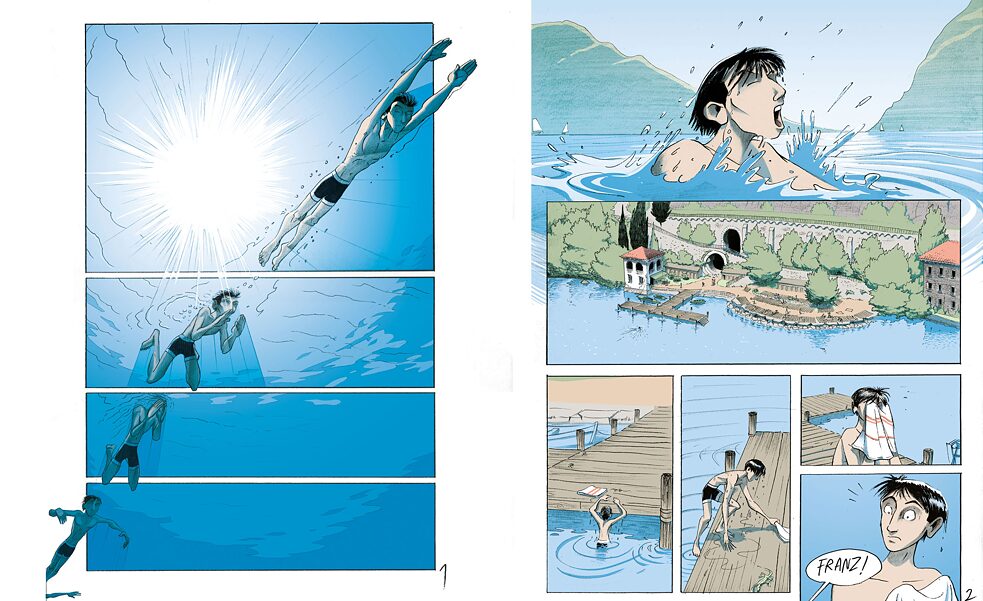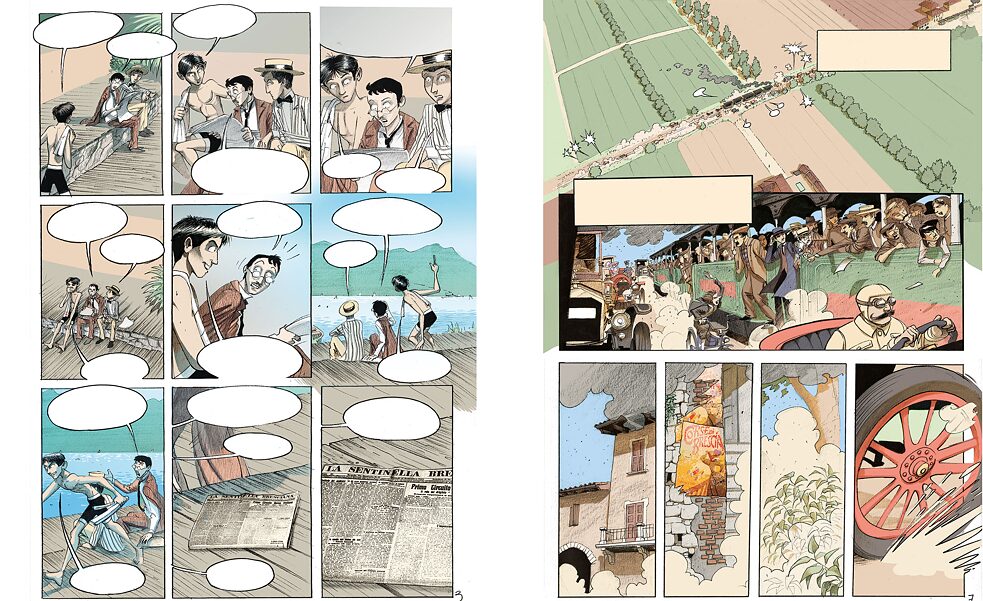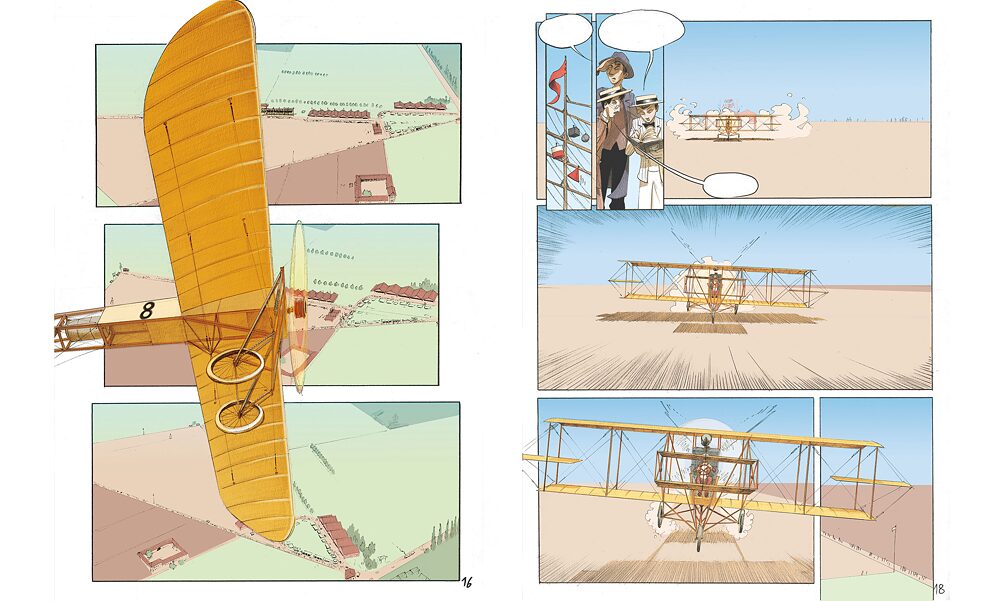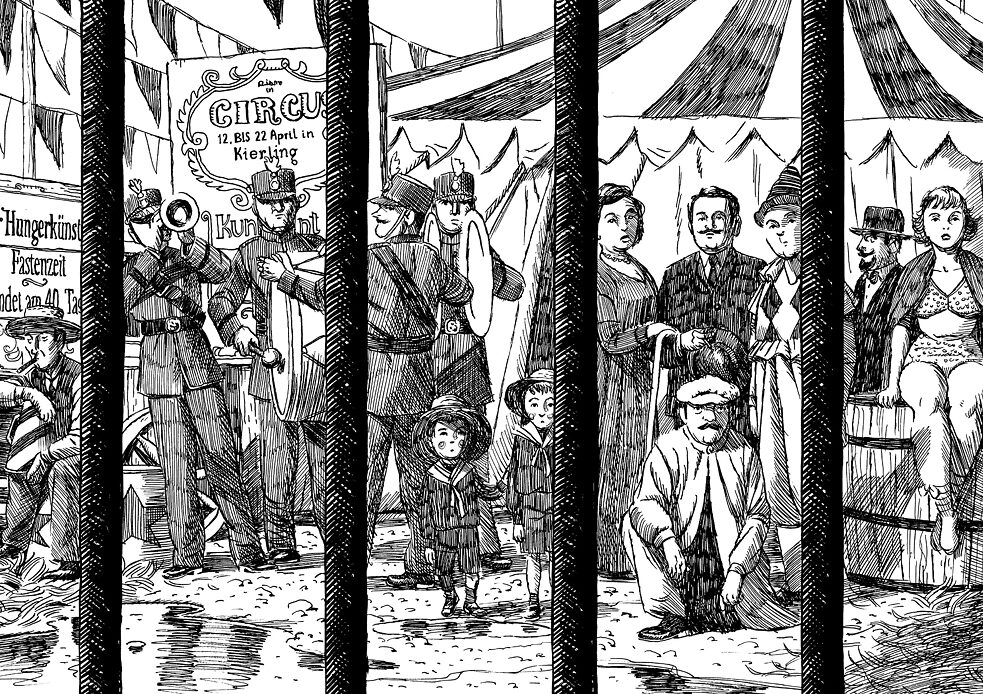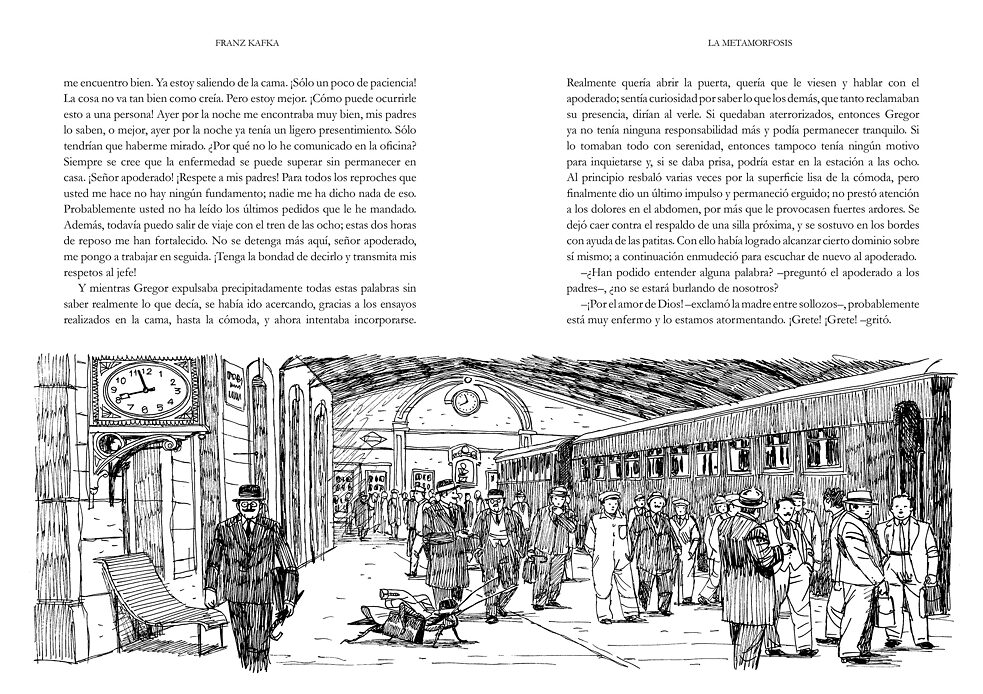Comics and graphic novels
Kafka in the realm of comics

Franz Kafka was himself a good illustrator and would surely have enjoyed these comics and graphic novels that were created by comic book artists from different parts of the world and all have one thing in common: the subject of Kafka.
We know that Franz Kafka was himself a good illustrator and also liked to go to the cinema. We can therefore presume that he might have enjoyed visual versions of his works, such as comics. From January 2024, an exhibition to accompany the book Komplett Kafka by the Austrian comic book artist Nicolas Mahler will tour Goethe-Institut branches around the world (organized by the Goethe-Institut Lyon). Mahler’s minimalistic line drawings are reminiscent of Kafka’s style of writing. However, Nicolas Mahler is by no means the first comic book author to adapt one of Kafka’s works or his biography to this form.
David Zane Mairowitz – the versatile scriptwriter
The most active of them is without doubt the US writer, journalist and director David Zane Mairowitz, who wrote the scripts for no fewer than three major Kafka adaptations, all in quite different styles.
First we have Introducing Kafka, which gives us an introduction to Kafka’s life and work. It was illustrated no less ingeniously by Robert Crumb, the grandmaster of US underground comics who is famous for characters such as Mr. Natural and Fritz the Cat, as well as for numerous autobiographical comics and the Bible adaptation The Book of Genesis. Mairowitz and Crumb focus on the one hand on the historical background to Kafka’s life (Bohemia as part of the Austro-Hungarian Empire, the First World War, omnipresent anti-Semitism, the emergence of Czechoslovakia) and on the other on his obsessions and traumas, such as the way he suffered from his dominating father, his self-loathing and his fears associated with women. His life merges almost seamlessly with his work here, showcased in powerful images that come courtesy of Crumb, who once said of Kafka that he was “my brother in spirit”, and his expressive style full of hatching.
For The Castle (German Das Schloss, Czeck Zámek), Mairowitz collaborated with the Czech illustrator and singer Jaromír 99 (Jaromír Švejdík), who is known above all for his work on the comic and animated film Alois Nebel together with the writer Jaroslav Rudiš. Alongside Rudiš, he is also one of the two singers in the Kafka Band, which will be setting off on an extensive European tour to celebrate the anniversary year 2024. Jaromír 99 works with bold black-grey-white contrasts that are similar to woodcuts. Everything appears as sharply defined as it does oppressive and mysterious.
Then we have The Trial (French Le procès, German Der Process) from the well-known French comic book artist, painter and press illustrator Chantal Montellier. She is known for example for Tchernobyl mon amour or her autobiography La Reconstitution. Employing a realistic-surrealist style, she gives the protagonist Josef K. Kafka’s own facial features – which on account of the biographical content of his works are to be found repeatedly in the adaptations.
A large number of French adaptations
France in general boasts a plethora of Kafka adaptations in graphic novel form, which is perhaps no surprise given its rich comic book scene.
Céka (Erick Lasnel) and Clod (Claude Voirriot) also did a version of Le procès (not translated into English), though everything comes across a bit less oppressive thanks to their colourful and cheerful illustrative style. Small visual gags loosen and liven the story up a bit – Joseph K. works at Brod Bank, where all kinds of things are labelled with the letter “K”, he meets a priest with a wire halo attached to his head, and finally receives a wreath from Max Brod on his execution. Nonetheless, the absurdity of the mysterious trial to which K. ultimately falls victim is not ignored – it finds its expression in the overflowing mountains of files, confusing buildings with big hall-like rooms and labyrinthine staircases, and the final scene in which Joseph K. is to be seen carrying his decapitated head under his arm.
Sylvain Ricard and Maël, both pros with years of experience under their belts, create a quite different atmosphere for us in Dans la colonie pénitentiaire (In the Penal Colony). A member of parliament from the motherland visits a penal colony situated in the desert, where he is requested to bear witness to the execution of a man who has been condemned to death for a triviality. In this intimate piece of theatre, which has been stripped down to the bare essentials and is full of haunting images in ochre hues, the obsession of the officer on duty and the brutality of the method of punishment are portrayed by vivid pantomime expressions on the characters’ faces. In the end, the accused is released and the officer himself is killed by the torture device. That said, the danger is not yet averted, as the supporters of this cruel punishment are lurking in wait for a opportune moment to return.
 Alexandre Kha: Les monstres aux pieds d’argile
| Courtesy / © Éditions Tanibis
Alexandre Kha adapts several of the German classics in his volume Les monstres aux pieds d’argile (not translated into English, but literally: The Monsters with Feet of Clay). They include three of Kafka’s stories (A Report for an Academy, Metamorphosis, A Hunger Artist). Arthur, one of Kha’s recurring characters, encounters various people in a big city who are regarded as “monsters” by their fellow inhabitants and tell him their stories. In black-and-green illustrations full of charm and odd melancholy, the author reveals his sympathy for these unwilling misfits.
Alexandre Kha: Les monstres aux pieds d’argile
| Courtesy / © Éditions Tanibis
Alexandre Kha adapts several of the German classics in his volume Les monstres aux pieds d’argile (not translated into English, but literally: The Monsters with Feet of Clay). They include three of Kafka’s stories (A Report for an Academy, Metamorphosis, A Hunger Artist). Arthur, one of Kha’s recurring characters, encounters various people in a big city who are regarded as “monsters” by their fellow inhabitants and tell him their stories. In black-and-green illustrations full of charm and odd melancholy, the author reveals his sympathy for these unwilling misfits.In their extensive graphic novel L’Amérique, Daniel Casanave and Robert Cara stage Kafka’s uncompleted novel Amerika in dynamic black-and-white images full of hatching. The confusing new world in which the young Karl Roßmann has to find his way, but in which he cannot trust everyone, is hauntingly depicted in grandiose (urban) landscapes and with highly expressive characters.
The prolific scriptwriter Corbeyran (Éric Corberand), known for such diverse works as Le Chant des stryges (a fantasy thriller) and Zélie et compagnie (a children’s comic), and the illustrator Horne (Horne Perreard) also embrace Kafka in their work. In drawings that are as sharp as they are gloomy, with their muted colours, they portray Gregor Samsa’s Metamorphosis (La Métamorphose) into a helpless insect.
Metamorphoses abound
 La metamorfosis from the Manga de dokuha series | Bargain Sakuraichi (Toshifumi Sakurai): La métamorphose
| Courtesy / © Herder Editorial and Akata Editions
Metamorphosis is in any case the most popular of the adapted works by Kafka. Three Japanese comic book authors have also tried their hand at this novella.
La metamorfosis from the Manga de dokuha series | Bargain Sakuraichi (Toshifumi Sakurai): La métamorphose
| Courtesy / © Herder Editorial and Akata Editions
Metamorphosis is in any case the most popular of the adapted works by Kafka. Three Japanese comic book authors have also tried their hand at this novella.On the one hand we have Bargain Sakuraichi (Toshifumi Sakurai), in whose manga Gregor Samsa’s perverse old father plays the main role; it is from his perspective that the tale is told. A financially ruined and rather lazy pensioner, he is forced to return to work following the metamorphosis of his son, who had previously provided for the family. Sakuraichi has created a black comedy whose protagonists tend to be characterized by their grotesquely distorted faces. The calculating and loveless “normal” people both within and outside his family are more repellent than Gregor the insect.
In simple, minimalistic and slightly caricatured images, Hiroyuki Sugahara depicts the metamorphosis of Gure Gôru (the Japanese pronunciation of “Gregor”). There is no shortage of humour, and the entire work can also be interpreted as a criticism of the working world and the harsh requirements that are placed on workers.
During my research I also stumbled across an anonymous comic in the style of older manga à la Astro Boy from the Manga de dokuha (まんがで読破 = Reading Through with Manga) series published by the Japanese company East Press, which aims to introduce a broad public to the literary classics. In it, elements from Kafka’s life and references to his other works are also interwoven with the tale of Metamorphosis.
With Kafka to America
The US comic author Peter Kuper has dealt extensively with Kafka and published three volumes of short stories: The Metamorphosis, Give It Up! and Kafkaesque. In expressive and dynamic black-and-white contrasts, he designs gloomy visual worlds that are sharp, precise and to the point. In some cases, today’s America with its modern cities rather than the tranquil turn-of-the-century Prague serves as the visual setting for Kafka’s tales (including Metamorphosis, A Hunger Artist and Give It Up!).
Réal Godbout, a Canadian artist who has played a key role in boosting the comic scene in Quebec, gives us Amerika. In the ligne claire style, we accompany the somewhat naive Karl Roßmann on his journey to New York and to the American heartland. His tragicomical adventures paint an unusual yet oddly realistic picture of America. There are several visual references to the films of Charly Chaplin and Orson Welles, and even Kafka himself lends his facial features to a minor character.
In Kafka’s native language
In the epilogue to Moritz Stetter’s comic Das Urteil (The Judgement), Kafka expert Reiner Stach explicitly praises the work as a viable way to visually interpret the Prague author. The artist, known for his graphic novels Bonhoeffer and Luther, creates a positively expressionistic setting for the tale. He juggles with the visual elements – the protagonist’s father shrinks at one point to the size of a baby and shortly afterwards becomes a giant. The beard of Gregor’s friend in St. Petersburg grows rampantly into a kind of impenetrable jungle. Towards the end of the book, the previously straight-lined structure of the panels collapses like scattered shards of a mirror – until Gregor plunges into the river, when the protagonist, as indeed the pictorial structure itself, dissolves completely.Stach likewise gave his official endorsement to Die Aeroplane in Brescia (The Aeroplanes at Brescia) by Moritz von Wolzogen. Published in 2022, this comic with its vivid and brightly coloured illustrations is based on one of Kafka’s lesser known texts: a report about an airshow in northern Italy that the young author watched with his friends Max and Otto Brod. We experience their journey and the world of early aviation in the bustling city of Brescia as a fun, carefree adventure – and thus see Kafka himself in a more light-hearted and positive light than usual.
Martin Frei’s Kafkaesque sci-fi thriller
The versatile author Martin Frei, who is at home in such diverse genres as crime (Kommissar Eisele), Western (Die Frau mit dem Silberstern) and superhero parody (Superbabe), brings us not an adaptation but a Kafka-inspired story of its own kind. In Gregor Ka im 21. Jahrhundert, the “Ten”, a conglomerate of mighty corporations, has seized power in Germany and is ruling with an iron rod. Gregor Ka, a respectable insurance clerk, is embroiled against his will in a rebellion against the new rulers. Virtual reality, genetic manipulation and extraterrestrial technology all play a role. Gregor Ka not only looks like Kafka’s ghostly double but also has a lover named Felice Bauer and a weakness for a data thief called Dora. The terrible visions that haunt him, his hesitant nature, his intermittent “metamorphosis” into a monster and the grinding bureaucracy of the “Ten” round off this Kafkaesque work.And finally....
Incidentally, it is worth mentioning that the well-known Spanish comic author Paco Roca (Rides, The Winter of the Cartoonist, The House) has illustrated a volume of Kafka’s tales: La metamorfosis y otros cuentos. He brings Kafka’s world to life in black-and-white drawings with considerable hatching that are partly realistic and partly fantastical.
In conclusion, one can certainly say that Kafka’s timeless themes remain as topical as ever and continue to fascinate comic book artists from different parts of the world. All of his main works have been adapted into comic form at least once, if not several times, with Metamorphosis – being Kafka’s perhaps best-known and most striking story – leading the field. The comic versions discussed in this article showcase the entire bandwidth of genres and are as creative as they are successful. The selection does not claim to be exhaustive.
A big thanks goes out to the wonderful publishers and authors for providing the beautiful pictures: Filip (Reprodukt), Emma (SelfMadeHero), Claude (Éditions Tanibis), Jean-Philippe (6 pieds sous terre éditions), Cindy (Akata Editions), Alba (Herder Editorial), Peter Kuper, Valérie (La Pasteque), Victor (Astiberri) und Moritz von Wolzogen

